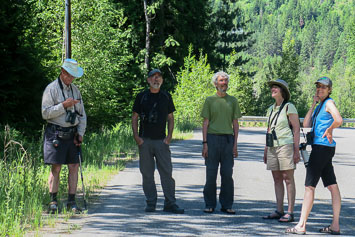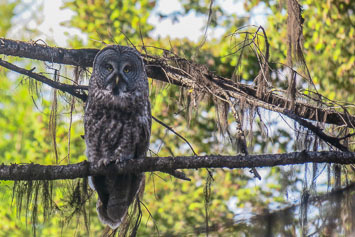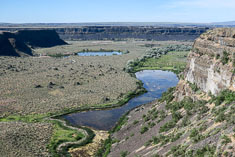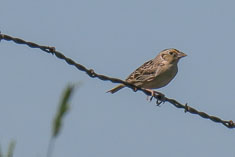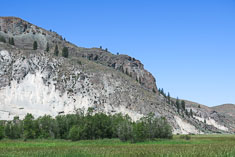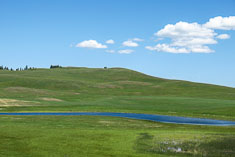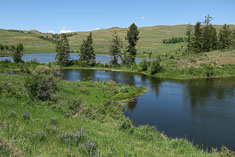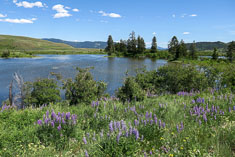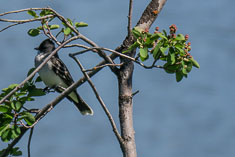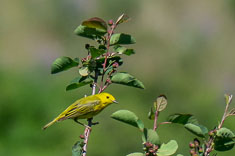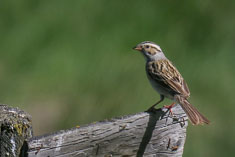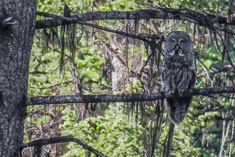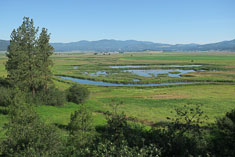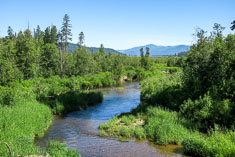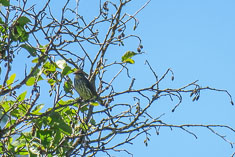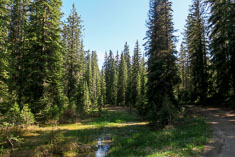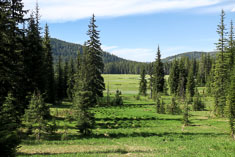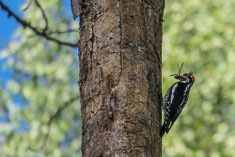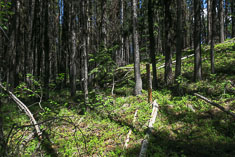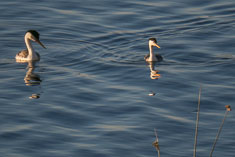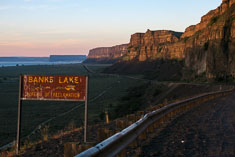Eastern Washington Birding Trip Report
June 3-7 2016
Text by Andy Stepniewsky, Photos by Brian Pendleton
Six intrepid birders and naturalists hit the eastern Washington Birding Trail for three full days of
birding and naturalizing, reaching the far northeast corner of our beautiful state. We were: Ed
Newbold and Delia Scholes, Brian Pendleton and Darchelle Worley, and Andy and Ellen Stepniewski.
Though the forecast for hot weather turned out to be an accurate one, we all were game for early
starts to take full advantage of the cool morning hours. Plus, we spent a good share of the hottest
time of day at higher elevations in the mountains, so we survived what few hours we were in hot
spots. As Ellen and I study and marvel the dramatic contrasts in vegetation and landforms in our
beautiful state, I offer tidbits on Washington's natural history in this account to share our love
of the incredibly varied flora, fauna, and geology we encountered on our trip.
3 June Windy point, Satus Creek
After everybody arrived at Windy Point, we set off in late afternoon to south of Toppenish and up Satus Creek. This area straddles two ecoregions: the Columbia Plateau and the lower East Cascades. Along the streamside Black Cottonwoods, White Alders and Oregon White Oaks (the last two suggesting a Californian and thus Mediterranean influence) in the Yakama Indian Reservation, we made a couple stops for the target Ash-throated Flycatcher. Our first stop at Dry Creek did not yield an ash-throat, but we did spot a distant Lark Sparrow. Common Nighthawks "beeped" overhead. Highway traffic noise was definitely a problem and so we didn't spend much time here.
Farther south along Satus Creek near Milepost 43 at a WA DOT gravel storage site, we could get away from the highway and into Oregon White Oak and shrub-steppe habitat edging the riparian habitat along the creek. We first heard, then saw an Ash-throated Flycatcher, here near the northern limits of its distribution. In areas of gravel soil I shared several of the buckwheats, the shrub-steppe's main sources of nectar. Also, showy Purple Sage was in bloom. We undertook a squeeze and smell test of its leaves to savor the delicious aromas of this "sage," a misnomer for it is actually a true mint. Lewis's Woodpeckers and Lazuli Buntings were other birds we'll remember here.
We stopped for a few minutes at US-97 at Tule Road, thinking Grasshopper Sparrow but highway noise and the hot temps definitely were a handicap, not to mention severe overgrazing by feral horses of the Bluebunch Wheatgrass on the hillsides here may well have wrecked the habitat for this grass-loving species. Time to head back to the ranch for dinner!
We returned to Andy and Ellen's home to have dinner on the deck in their garden, with Black-chinned Hummingbirds zipping by the feeders and Vaux's Swifts twittering overhead.
After everybody arrived at Windy Point, we set off in late afternoon to south of Toppenish and up Satus Creek. This area straddles two ecoregions: the Columbia Plateau and the lower East Cascades. Along the streamside Black Cottonwoods, White Alders and Oregon White Oaks (the last two suggesting a Californian and thus Mediterranean influence) in the Yakama Indian Reservation, we made a couple stops for the target Ash-throated Flycatcher. Our first stop at Dry Creek did not yield an ash-throat, but we did spot a distant Lark Sparrow. Common Nighthawks "beeped" overhead. Highway traffic noise was definitely a problem and so we didn't spend much time here.
Farther south along Satus Creek near Milepost 43 at a WA DOT gravel storage site, we could get away from the highway and into Oregon White Oak and shrub-steppe habitat edging the riparian habitat along the creek. We first heard, then saw an Ash-throated Flycatcher, here near the northern limits of its distribution. In areas of gravel soil I shared several of the buckwheats, the shrub-steppe's main sources of nectar. Also, showy Purple Sage was in bloom. We undertook a squeeze and smell test of its leaves to savor the delicious aromas of this "sage," a misnomer for it is actually a true mint. Lewis's Woodpeckers and Lazuli Buntings were other birds we'll remember here.
We stopped for a few minutes at US-97 at Tule Road, thinking Grasshopper Sparrow but highway noise and the hot temps definitely were a handicap, not to mention severe overgrazing by feral horses of the Bluebunch Wheatgrass on the hillsides here may well have wrecked the habitat for this grass-loving species. Time to head back to the ranch for dinner!
We returned to Andy and Ellen's home to have dinner on the deck in their garden, with Black-chinned Hummingbirds zipping by the feeders and Vaux's Swifts twittering overhead.
4 June Grand Coulee, Okanagan Highlands
As I had warned of hot weather, everybody was keen to get an early start. For once, it wasn't I who recommended a 4 am wakeup ! We were at Vantage on Recreation Drive north a short stretch from the Vantage Highway very soon after dawn hoping to spot a Black-throated Sparrow. Well, it doesn't appear if this species is making one of its unpredictable pushes north from Oregon this year, at least not yet, because this site with shrub-steppe, basalt outcrops, and talus, is usually a good one. We did hear some typical Columbia Plateau birds: Say's Phoebe, Rock Wren, and Western Meadowlark. We tried again for the Black-throated Sparrow south of I-90 along Huntzinger Road, especially in a basalt-rimmed bowl about a half mile south of the entrance to Wanapum State Park. Shrub-steppe birds were few, but we did add Common Loon to our trip list out on Wanapum Pool, a slackwater reservoir of the Columbia River.
Northwards in the Columbia Basin, we stopped at the south end of Soap Lake where we birded from the city park at the southeast corner of the lake. Birds wedded to alkaline waters were especially evident: Ruddy Duck, Eared Grebe, and the showy American Avocet, were all noted.
Lenore Lake, at its south end, proved productive as we scoped the glass calm lake with the cliff walls of the Lower Grand Coulee providing a stunning sight in the early morning light. A hen Barrow's Goldeneye with its brood of four ducklings was cool. This is one of the chief sites in Washington for this species' distribution. Here it nests in rock slides or cliffs. Usually it nests in tree-fringed boreal lakes apart from treeless Iceland. We also studied Loggerhead Shrikes, one bird a brownish recently fledged young. We stopped again farther north along Lenore Lake where we scoped from a boat launch about a mile north of the south end of the lake. We especially searched for a Franklin's Gull in the large gull and cormorant colony, without success. These birds were a bit distant for a true assessment of gull species composition. Once again, the towering basalt cliff walls and their impressive talus aprons provided a visual treat for our birding.
Dry Falls Interpretive Center at the top end of the Lower Grand Coulee is a "must-see," for here the enormous erosive power of the many Lake Missoula Floods is on grand display, making this one of the scenic highlights in the Pacific Northwest. Noted writer and naturalist Peter Matthiessen, speaking at an Othello Sandhill Crane Festival a few years ago, remarked the sight of this geological wonder and insight into its origin left him awestruck. The overlook here is well-known for its White-throated Swifts. These dashing birds were high in the sky while we were at the cliff edge. Perhaps their insect prey was high in the sky on account of the warm weather.
. Coulee City Sewage Ponds has quickly gained a reputation as a site for good birds so we scoped the big ponds here, once again hoping for a Franklin's Gull. Well, once again no luck, but had nice views of quite an assortment of ducks.
Up on the Waterville Plateau in the northern Columbia Plateau, I judged a good spot for Grasshopper Sparrow might be Conservation Reserve Program (CRP) fields of "regenerating shrub-steppe" beside SR-17 one mile north of its junction with SR-155. CRP is a USDA set-aside which pays farmers to plant native grasses on economically marginal sites to inhibit erosion and promote habitat restoration. It turns out this program has been fabulously successful in its goals. Indeed, the best hope for survival of Greater Sage-Grouse in Washington appears to be on lands enrolled in this program. Grasshopper Sparrows have benefited, too, as we heard one the instant we stepped out of our cars!
Descending to Bridgeport we crossed the Columbia River at Chief Joseph Dam, which has no fish ladders and thus marks the upper limit of salmon on the river. This area also marks the abrupt boundary between the Columbia Plateau and Okanogan Ecoregions. We were leaving the Columbia Plateau "young" basalts" which inundated the Columbia Basin from northeastern Oregon. These basalts were abruptly stopped when the outpourings of fluid basalt made contact with much older rocks of the Okanogan region, chiefly metamorphic rocks such as gneiss and granites. As we drove north in the Okanogan Valley, conspicuous terraces appear as if glued on the valley sides. These are Kame Terraces, a glacial feature formed when the enormous valley glaciers flowed south from Canada in the Pleistocene, partially filling the valley. Silt-laden meltwater streams alongside the glacier deposited large volumes of poorly consolidated fill. After the glacier melted, this silt and rock rubble remain as terraces on the lower sides of the valley.
With Least Flycatcher in mind, we detoured a mile or so to the Cassimer Bar Wildlife Area at the US-97 bridge over the Okanogan River, here where it joins the "Columbia River," here slackwater Lake Pateros. We birded dense riparian woodland of introduced European Poplar and Black Cottonwood where Least Flycatcher often summer. "Leasties" didn't appear but we saw a few birds besides the placid waters of the Okanogan River, most notably a Lazuli Bunting.
Continuing northward past Omak, we stopped by Crumbacher Lake, an impressive glacial "kettle" lake set at the base of tall cliffs. In the open Ponderosa Pine forest, several Gray Flycatchers sang their distinctive rough notes. Otherwise, birds were few on this warm afternoon.
Northeast from Tonasket and just as we began a climb up into the Okanogan Highlands, we stopped at Siwash Creek Rd. at the junction with Havillah Road where we scanned the extensive hayfields and soon saw and heard Bobolinks, always a memorable occasion. In the lower Okanogan Highlands, we stopped along Fancher Dam Road for a few minutes, birding the dry Ponderosa Pine forest. We noted species typical of the dry forest such as Western Wood-Pewee, Gray Flycatcher, and Pygmy Nuthatch. Upwards from here, we entered a beautiful mosaic of mixed-conifer forest and grasslands, with small lakes here and there, making this part of the Okanogan Highlands one of the prettiest in Washington. Higher into the Okanogan Highlands, at the turnoff from Havilah onto Hungry Hollow Road, we made the briefest stop but were rewarded with a singing Olive-sided Flycatcher.
We then scoped Muskrat Lake which has more water than the last couple years but its still a tiny puddle compared to its former glory in the 1990s. The lakes and rounded topography in the Okanogan Highlands owe their existence to the awesome erosive powers of the Ice Age glaciers, which buried the entire region in thousands of feet of ice, overriding completely every mountain in this region. This is in stark contrast to the serrated peaks of the Cascade Range crest nearly 100 miles to the west, which rose above this sheet of ice and were affected only by valley glaciers plucking away at their slopes. Birdwise, we did note a few ducks in the lake, heard a Sora whinnying from the marsh and a Swainson's Hawk soared in the distance.
Fields Lake seemed to have fewer ducks than in past years and the usual Black Terns were nowhere to be seen. Still, we noted seven species of waterfowl. Gray Catbirds posed for some of us, a species common in Northeastern Washington. North from Fields Lake and about one mile south of Mary Ann Creek Road, we stopped by the roadside and focused on the brushy patches on hillsides, often good for Clay-colored Sparrow. We heard and saw two of these prairie sparrows. Most bizarre, though, was a singing Sage Thrasher here! Though this thrasher had the correct structural character (an extensive brushy patch) to its choice of territory, it was significantly off the mark in terms of the species composition of its brushfield (not shrub-steppe). I wondered aloud what the chance was of a female arriving here to form a nesting pair.
With Great Gray Owl a target species, we headed into the Chesaw Wildlife Area from the village of Chesaw, granted vehicle entry by WDFW. We spent a full three hours in the late afternoon, combing the mixed-conifer forest for a Great Gray Owl, trying to hone in on an occupied nest platform. Well, we never located the proper platform, but we had a marvelous "Treasure Hunt," as Darchelle called our adventure. By and by, while I was hiking down a ravine, a calling Cooper's Hawk hinted it might be irritated by an owl so I wandered a bit and was excited to see our target owl perched not one hundred feet below me. Now to get the others onto this great "Phantom of the North." With radio contact I first got Ellen on to the bird. She got a quick photo before racing off to round up the others. The owl stayed on its branch long enough for all to see and study this No. 1 target, truly a "peak" birding experience!
Chewelah is a long, long ways from Chesaw so we hurried east, though stopping to admire a Black Tern at Beth Lake, set in a beautiful, densely forested gorge, a magnificent setting, indeed. We dallied longer than we should here for other birds caught our attention. A Barrow's Goldeneye hen with ducklings sat placidly on one end of a floating log, while a Mallard and her brood sat at the other end. Across the lake a female Hooded Merganser swam on the serene water. Nearby, an adult Bald Eagle perched, waiting for a hunting opportunity. Spotted Sandpipers calls echoed in the narrow chasm.
With the late hour, time for open restaurants was running out, we stopped for Mexican food in Republic (yummy, with good beer choices). We lodged at the Nordlig in Chewelah, quite adequate save for the "Continental Breakfast." Here was the skimpiest breakfast offering any of had ever seen at a motel!
As I had warned of hot weather, everybody was keen to get an early start. For once, it wasn't I who recommended a 4 am wakeup ! We were at Vantage on Recreation Drive north a short stretch from the Vantage Highway very soon after dawn hoping to spot a Black-throated Sparrow. Well, it doesn't appear if this species is making one of its unpredictable pushes north from Oregon this year, at least not yet, because this site with shrub-steppe, basalt outcrops, and talus, is usually a good one. We did hear some typical Columbia Plateau birds: Say's Phoebe, Rock Wren, and Western Meadowlark. We tried again for the Black-throated Sparrow south of I-90 along Huntzinger Road, especially in a basalt-rimmed bowl about a half mile south of the entrance to Wanapum State Park. Shrub-steppe birds were few, but we did add Common Loon to our trip list out on Wanapum Pool, a slackwater reservoir of the Columbia River.
Northwards in the Columbia Basin, we stopped at the south end of Soap Lake where we birded from the city park at the southeast corner of the lake. Birds wedded to alkaline waters were especially evident: Ruddy Duck, Eared Grebe, and the showy American Avocet, were all noted.
Lenore Lake, at its south end, proved productive as we scoped the glass calm lake with the cliff walls of the Lower Grand Coulee providing a stunning sight in the early morning light. A hen Barrow's Goldeneye with its brood of four ducklings was cool. This is one of the chief sites in Washington for this species' distribution. Here it nests in rock slides or cliffs. Usually it nests in tree-fringed boreal lakes apart from treeless Iceland. We also studied Loggerhead Shrikes, one bird a brownish recently fledged young. We stopped again farther north along Lenore Lake where we scoped from a boat launch about a mile north of the south end of the lake. We especially searched for a Franklin's Gull in the large gull and cormorant colony, without success. These birds were a bit distant for a true assessment of gull species composition. Once again, the towering basalt cliff walls and their impressive talus aprons provided a visual treat for our birding.
Dry Falls Interpretive Center at the top end of the Lower Grand Coulee is a "must-see," for here the enormous erosive power of the many Lake Missoula Floods is on grand display, making this one of the scenic highlights in the Pacific Northwest. Noted writer and naturalist Peter Matthiessen, speaking at an Othello Sandhill Crane Festival a few years ago, remarked the sight of this geological wonder and insight into its origin left him awestruck. The overlook here is well-known for its White-throated Swifts. These dashing birds were high in the sky while we were at the cliff edge. Perhaps their insect prey was high in the sky on account of the warm weather.
. Coulee City Sewage Ponds has quickly gained a reputation as a site for good birds so we scoped the big ponds here, once again hoping for a Franklin's Gull. Well, once again no luck, but had nice views of quite an assortment of ducks.
Up on the Waterville Plateau in the northern Columbia Plateau, I judged a good spot for Grasshopper Sparrow might be Conservation Reserve Program (CRP) fields of "regenerating shrub-steppe" beside SR-17 one mile north of its junction with SR-155. CRP is a USDA set-aside which pays farmers to plant native grasses on economically marginal sites to inhibit erosion and promote habitat restoration. It turns out this program has been fabulously successful in its goals. Indeed, the best hope for survival of Greater Sage-Grouse in Washington appears to be on lands enrolled in this program. Grasshopper Sparrows have benefited, too, as we heard one the instant we stepped out of our cars!
Descending to Bridgeport we crossed the Columbia River at Chief Joseph Dam, which has no fish ladders and thus marks the upper limit of salmon on the river. This area also marks the abrupt boundary between the Columbia Plateau and Okanogan Ecoregions. We were leaving the Columbia Plateau "young" basalts" which inundated the Columbia Basin from northeastern Oregon. These basalts were abruptly stopped when the outpourings of fluid basalt made contact with much older rocks of the Okanogan region, chiefly metamorphic rocks such as gneiss and granites. As we drove north in the Okanogan Valley, conspicuous terraces appear as if glued on the valley sides. These are Kame Terraces, a glacial feature formed when the enormous valley glaciers flowed south from Canada in the Pleistocene, partially filling the valley. Silt-laden meltwater streams alongside the glacier deposited large volumes of poorly consolidated fill. After the glacier melted, this silt and rock rubble remain as terraces on the lower sides of the valley.
With Least Flycatcher in mind, we detoured a mile or so to the Cassimer Bar Wildlife Area at the US-97 bridge over the Okanogan River, here where it joins the "Columbia River," here slackwater Lake Pateros. We birded dense riparian woodland of introduced European Poplar and Black Cottonwood where Least Flycatcher often summer. "Leasties" didn't appear but we saw a few birds besides the placid waters of the Okanogan River, most notably a Lazuli Bunting.
Continuing northward past Omak, we stopped by Crumbacher Lake, an impressive glacial "kettle" lake set at the base of tall cliffs. In the open Ponderosa Pine forest, several Gray Flycatchers sang their distinctive rough notes. Otherwise, birds were few on this warm afternoon.
Northeast from Tonasket and just as we began a climb up into the Okanogan Highlands, we stopped at Siwash Creek Rd. at the junction with Havillah Road where we scanned the extensive hayfields and soon saw and heard Bobolinks, always a memorable occasion. In the lower Okanogan Highlands, we stopped along Fancher Dam Road for a few minutes, birding the dry Ponderosa Pine forest. We noted species typical of the dry forest such as Western Wood-Pewee, Gray Flycatcher, and Pygmy Nuthatch. Upwards from here, we entered a beautiful mosaic of mixed-conifer forest and grasslands, with small lakes here and there, making this part of the Okanogan Highlands one of the prettiest in Washington. Higher into the Okanogan Highlands, at the turnoff from Havilah onto Hungry Hollow Road, we made the briefest stop but were rewarded with a singing Olive-sided Flycatcher.
We then scoped Muskrat Lake which has more water than the last couple years but its still a tiny puddle compared to its former glory in the 1990s. The lakes and rounded topography in the Okanogan Highlands owe their existence to the awesome erosive powers of the Ice Age glaciers, which buried the entire region in thousands of feet of ice, overriding completely every mountain in this region. This is in stark contrast to the serrated peaks of the Cascade Range crest nearly 100 miles to the west, which rose above this sheet of ice and were affected only by valley glaciers plucking away at their slopes. Birdwise, we did note a few ducks in the lake, heard a Sora whinnying from the marsh and a Swainson's Hawk soared in the distance.
Fields Lake seemed to have fewer ducks than in past years and the usual Black Terns were nowhere to be seen. Still, we noted seven species of waterfowl. Gray Catbirds posed for some of us, a species common in Northeastern Washington. North from Fields Lake and about one mile south of Mary Ann Creek Road, we stopped by the roadside and focused on the brushy patches on hillsides, often good for Clay-colored Sparrow. We heard and saw two of these prairie sparrows. Most bizarre, though, was a singing Sage Thrasher here! Though this thrasher had the correct structural character (an extensive brushy patch) to its choice of territory, it was significantly off the mark in terms of the species composition of its brushfield (not shrub-steppe). I wondered aloud what the chance was of a female arriving here to form a nesting pair.
With Great Gray Owl a target species, we headed into the Chesaw Wildlife Area from the village of Chesaw, granted vehicle entry by WDFW. We spent a full three hours in the late afternoon, combing the mixed-conifer forest for a Great Gray Owl, trying to hone in on an occupied nest platform. Well, we never located the proper platform, but we had a marvelous "Treasure Hunt," as Darchelle called our adventure. By and by, while I was hiking down a ravine, a calling Cooper's Hawk hinted it might be irritated by an owl so I wandered a bit and was excited to see our target owl perched not one hundred feet below me. Now to get the others onto this great "Phantom of the North." With radio contact I first got Ellen on to the bird. She got a quick photo before racing off to round up the others. The owl stayed on its branch long enough for all to see and study this No. 1 target, truly a "peak" birding experience!
Chewelah is a long, long ways from Chesaw so we hurried east, though stopping to admire a Black Tern at Beth Lake, set in a beautiful, densely forested gorge, a magnificent setting, indeed. We dallied longer than we should here for other birds caught our attention. A Barrow's Goldeneye hen with ducklings sat placidly on one end of a floating log, while a Mallard and her brood sat at the other end. Across the lake a female Hooded Merganser swam on the serene water. Nearby, an adult Bald Eagle perched, waiting for a hunting opportunity. Spotted Sandpipers calls echoed in the narrow chasm.
With the late hour, time for open restaurants was running out, we stopped for Mexican food in Republic (yummy, with good beer choices). We lodged at the Nordlig in Chewelah, quite adequate save for the "Continental Breakfast." Here was the skimpiest breakfast offering any of had ever seen at a motel!
5 June Chewelah, Calispell Lake, Bunchgrass Meadows
After crossing the Columbia River at Kettle Falls, we had left the Okanogan and entered the Canadian Rocky Mountains Ecoregion. At our first birding venue in the morning, we found amazing habitat diversity on Hafer Road, a short stretch south of Chewelah and east of US-395: pond, marsh, riparian woods, rank grasslands, mowed fields, brushy slopes, and pine woods. The grasslands and brushy patches had two singing Clay-colored Sparrow (just east of the power lines and again another 1/2 mile east). The Ponderosa Pine woodland near the marsh and pond overlook had a Least Flycatcher, as last year. The marsh and pond area was great for scope views of waterfowl. Ellen and I made two visits here, one at 6AM and again with the others at 8AM. Our two-visit list totaled 55 species!
East from Chewelah up Flowery Trail Road on the west side of the pass, we stopped several times in mixed-conifer forest. Wild Turkeys slipping into the forest, were new for our trip list. East of the 49 Degrees North Ski Resort Along Flowery Trail Road, we stopped in "Interior Wet Belt" forest with Western Red-cedar, Western Hemlock, and Engelmann Spruce. Chesnut-backed Chickadees called and Pacific Wrens sang their jingly song.
A favorite spot for "eastern" species in Washington is the Westside Calispell Road, particularly a bridge offering vantages of the riparian strip both upstream and downstream. Here, we easily picked up Red-eyed Vireo, Gray Catbird, Northern Waterthrush, and, with a bit more effort, American Redstart. Not far away, we could hear a Bobolink or two singing, thus five species with their main distribution east of the Rocky Mountains.
We then toured around the west side of Calispell Lake along West Calispell Lake Road, stopping 1.6 miles south of McKenzie Road by an open pine grove. Through an opening in the trees, we scoped Black Terns hawking insects over the marsh. Closer inspection revealed a Forster's Tern. We noted this small, white-bodied tern near Black Terns and could see it sported whitish upper wings, so not a late migrant Common Tern. In the brushy understory of the dry forest, Brian and I tackled identification of a singing Empidonax and settled on Dusky Flycatcher, actually a couple singing birds. We had now seen all the Washington "gnat kings" (literal translation of Empidonax) on this trip! Farther along the lake, we scoped the lake from two more vantage points along West Calispell Lake Road west of the lake. Though distant views, we added more species to our Calispell Lake area list.
We also viewed the pretty post glacial landscape alongside Calispell Lake. Mighty trunk glaciers gouged the mountains and valleys as they scoured and eroded everything in their path on their southward march from Canada. The smooth valley bottom stretching from mountainside-to-mountainside is clear evidence a lake filled the valley as soon as the ice retreated northward. Now, 12,000 years later, much of the water is gone, filled in by river sediments from the surrounding slopes, leaving Calispell Lake but a tiny remnant of its former self.
We now headed to Washington's "Northeast Corner." The road to Salmo Pass was still closed due to snow but Bunchgrass Meadows was reportedly open. So, we headed up Harvey Road climbing, at lower elevations, through a dense Interior Wet Belt of Western Red-cedar Western Hemlock, and Engelmann Spruce, all besides rushing, crystal-clear Harvey Creek, flush with snow melt. This lower stretch boasted birds typical of wet forests: Pacific-slope Flycatcher, Pacific Wren, and Varied Thrush. Near Bunchgrass Meadows, the vegetation changes to a boreal forest dominated by Engelmann Spruce and Subalpine Fir with a dense shrub layer of huckleberries and White Rhododendron, and many mosses and lichens. We spent three hours along NF-1935 south up to the ridge 0.8 miles southwest of the meadows. We also briefly visited the edge of very soggy Bunchgrass Meadows, lush, green, and buggy with flies but not many mosquitoes. The bird species we were seeking such as Spruce Grouse, Boreal Chickadee, Pine Grosbeak, and White-winged Crossbill, were not around, despite our best efforts. Nevertheless, we had a good time searching. We'll need to return!
After crossing the Columbia River at Kettle Falls, we had left the Okanogan and entered the Canadian Rocky Mountains Ecoregion. At our first birding venue in the morning, we found amazing habitat diversity on Hafer Road, a short stretch south of Chewelah and east of US-395: pond, marsh, riparian woods, rank grasslands, mowed fields, brushy slopes, and pine woods. The grasslands and brushy patches had two singing Clay-colored Sparrow (just east of the power lines and again another 1/2 mile east). The Ponderosa Pine woodland near the marsh and pond overlook had a Least Flycatcher, as last year. The marsh and pond area was great for scope views of waterfowl. Ellen and I made two visits here, one at 6AM and again with the others at 8AM. Our two-visit list totaled 55 species!
East from Chewelah up Flowery Trail Road on the west side of the pass, we stopped several times in mixed-conifer forest. Wild Turkeys slipping into the forest, were new for our trip list. East of the 49 Degrees North Ski Resort Along Flowery Trail Road, we stopped in "Interior Wet Belt" forest with Western Red-cedar, Western Hemlock, and Engelmann Spruce. Chesnut-backed Chickadees called and Pacific Wrens sang their jingly song.
A favorite spot for "eastern" species in Washington is the Westside Calispell Road, particularly a bridge offering vantages of the riparian strip both upstream and downstream. Here, we easily picked up Red-eyed Vireo, Gray Catbird, Northern Waterthrush, and, with a bit more effort, American Redstart. Not far away, we could hear a Bobolink or two singing, thus five species with their main distribution east of the Rocky Mountains.
We then toured around the west side of Calispell Lake along West Calispell Lake Road, stopping 1.6 miles south of McKenzie Road by an open pine grove. Through an opening in the trees, we scoped Black Terns hawking insects over the marsh. Closer inspection revealed a Forster's Tern. We noted this small, white-bodied tern near Black Terns and could see it sported whitish upper wings, so not a late migrant Common Tern. In the brushy understory of the dry forest, Brian and I tackled identification of a singing Empidonax and settled on Dusky Flycatcher, actually a couple singing birds. We had now seen all the Washington "gnat kings" (literal translation of Empidonax) on this trip! Farther along the lake, we scoped the lake from two more vantage points along West Calispell Lake Road west of the lake. Though distant views, we added more species to our Calispell Lake area list.
We also viewed the pretty post glacial landscape alongside Calispell Lake. Mighty trunk glaciers gouged the mountains and valleys as they scoured and eroded everything in their path on their southward march from Canada. The smooth valley bottom stretching from mountainside-to-mountainside is clear evidence a lake filled the valley as soon as the ice retreated northward. Now, 12,000 years later, much of the water is gone, filled in by river sediments from the surrounding slopes, leaving Calispell Lake but a tiny remnant of its former self.
We now headed to Washington's "Northeast Corner." The road to Salmo Pass was still closed due to snow but Bunchgrass Meadows was reportedly open. So, we headed up Harvey Road climbing, at lower elevations, through a dense Interior Wet Belt of Western Red-cedar Western Hemlock, and Engelmann Spruce, all besides rushing, crystal-clear Harvey Creek, flush with snow melt. This lower stretch boasted birds typical of wet forests: Pacific-slope Flycatcher, Pacific Wren, and Varied Thrush. Near Bunchgrass Meadows, the vegetation changes to a boreal forest dominated by Engelmann Spruce and Subalpine Fir with a dense shrub layer of huckleberries and White Rhododendron, and many mosses and lichens. We spent three hours along NF-1935 south up to the ridge 0.8 miles southwest of the meadows. We also briefly visited the edge of very soggy Bunchgrass Meadows, lush, green, and buggy with flies but not many mosquitoes. The bird species we were seeking such as Spruce Grouse, Boreal Chickadee, Pine Grosbeak, and White-winged Crossbill, were not around, despite our best efforts. Nevertheless, we had a good time searching. We'll need to return!
6 June Big Meadow Lake, Sherman Pass, Lyman Lake
We spent the night in Ione at the Riverview Motel, situated on the very scenic Pend Oreille River. In the morning, we had breakfast from the deck overlooking the backed-up river, so a slackwater reservoir. We compiled a list of "breakfast" birds.
Just east of Ione, but heading west to Republic, we visited Big Meadow Lake, a beautiful spot with lake and marsh, rimmed by a mixedwood forest. This area is very bird-rich. In our short visit, we compiled quite a nice list. Common Goldeneye breeds regularly here, one of the few sites in Washington for this boreal breeder.
West from Colville and heading up Sherman Pass, we turned off SR-20 at Albian Hill Road. Spruce Grouse is never an easy bird to observe in Washington. Late spring is a particularly tough time, as the males have stopped displaying and females are hidden in the forest undergrowth, nesting. But we decided to give this elusive species a try on this road which heads north along the east side of the Kettle Crest. We especially slowed down in areas of prime grouse habitat, as along creek bottoms, in the even-aged Lodgepole Pine forest, and especially in areas with abundant undergrowth of Grouseberry and other huckleberries. Darchelle came the closest to observing our elusive quarry when she was walking the road and a "brown-winged bird of grouse size exploded from the thickets right at the edge of the road and disappeared with whirring wings." Brian and I both commented Darchelle was describing a grouse perfectly. Though we fared poorly on grouse, we did note lots of warblers in the regenerating Lodgepole Pine forest, in many areas with a nice and dense understory of Mountain Alders. Nashville was certainly the most abundant warbler, but Wilson's was also common in the areas where the alder was denser. In the treetop layer were Townsend's and Yellow-rumps.
We had a leisurely picnic lunch at the Old Stage Trailhead. An interpretive sign explained the efforts to connect this part of Washington to the west in the late 1800s with a proper road fit for a stagecoach. This effort was abandoned some years later with the building of a road over Sherman Pass. In the pleasant surroundings here (partial burn, but with a tall fir and spruce forest nearby), we listened and watched Olive-sided Flycatchers and finally heard and saw a Hairy Woodpecker, new for our trip list. After lunch we headed south on Albian Hill Road, ever alert for the elusive Spruce Grouse. We drove the road very slowly for another hour. The target chicken kept out-of-sight once again. Compensation came when we evidently startled a Pileated Woodpecker from the roadside pines, certainly an impressive bird!
In Republic, we spent10 minutes in the afternoon heat at West 6th and South Kean Streets, watching hummingbird feeders and were rewarded with our trip Calliope Hummingbird and several Black-chins.
Targeting Charlie Wright's Ovenbird reported the morning before near Lyman Lake, we headed south from Republic to Arenas Valley Road (BIA 64). We made our way west along this deteriorating road. For a short stretch, it was merely a 2-track and I think we all were nervous it was not going to go through, especially when we entered mostly burned forest, It was sunny and a sweltering 97 degrees but birds were still singing. Most surprising was at least three singing Veerys, including one singing in completely burned habitat, including all riparian shrubs turned to charred sticks! At the spot I interpreted, from the report on Tweeters, as the Ovenbird location (junction of Lyman Lake Road and Lyman Lake-Moses Meadow Road), we stopped and tried for the vagrant warbler. The landscape all around was open Ponderosa Pine forest. Most conspicuous were dry forest species such as Common Nighthawk, Mountain Chickadee, and Pygmy Nuthatch. We could not see any appropriate Ovenbird habitat and it was still quite hot, I soon suggested we abandon this search. The day after we returned home, better details of the location appeared on eBird. It became much more evident the Tweeters post gave inaccurate directions, as the bird was actually along SR-155 east of the Moses Meadow-Lyman Lake junction!
It was getting on towards evening when we hit Grand Coulee Dam, indeed a a sight to behold! and Banks Lake where we made several stops targeting Clark's Grebe. We hit pay dirt at a particularly scenic spot just south of Northrup Canyon along SR-155 (8.0 miles south of junction with SR-271). Looming above us near lake level we gawked at stupendous basalt cliffs of the Upper Grand Coulee, enlivened with colorful lichens lit by the low sun. Poking upwards from below were far older granites, one of the very few areas in the region where underlying and far more ancient rocks are exposed in the Columbia Plateau. We barely stopped along Banks Lake at Milepost 2 at 8:30 PM to check off a small group of American White Pelicans in a shallow bay off to the west, our last birding of our trip.
We finished our epic dryside journey, having explored and birded in four of the states nine distinct ecoregions: East Cascades, Columbia Plateau, Okanogan, and finally the Canadian Rocky Mountains. In all we tallied about 160 species of birds, reveled in incredible world-class scenery and enjoyed great fellowship!
We spent the night in Ione at the Riverview Motel, situated on the very scenic Pend Oreille River. In the morning, we had breakfast from the deck overlooking the backed-up river, so a slackwater reservoir. We compiled a list of "breakfast" birds.
Just east of Ione, but heading west to Republic, we visited Big Meadow Lake, a beautiful spot with lake and marsh, rimmed by a mixedwood forest. This area is very bird-rich. In our short visit, we compiled quite a nice list. Common Goldeneye breeds regularly here, one of the few sites in Washington for this boreal breeder.
West from Colville and heading up Sherman Pass, we turned off SR-20 at Albian Hill Road. Spruce Grouse is never an easy bird to observe in Washington. Late spring is a particularly tough time, as the males have stopped displaying and females are hidden in the forest undergrowth, nesting. But we decided to give this elusive species a try on this road which heads north along the east side of the Kettle Crest. We especially slowed down in areas of prime grouse habitat, as along creek bottoms, in the even-aged Lodgepole Pine forest, and especially in areas with abundant undergrowth of Grouseberry and other huckleberries. Darchelle came the closest to observing our elusive quarry when she was walking the road and a "brown-winged bird of grouse size exploded from the thickets right at the edge of the road and disappeared with whirring wings." Brian and I both commented Darchelle was describing a grouse perfectly. Though we fared poorly on grouse, we did note lots of warblers in the regenerating Lodgepole Pine forest, in many areas with a nice and dense understory of Mountain Alders. Nashville was certainly the most abundant warbler, but Wilson's was also common in the areas where the alder was denser. In the treetop layer were Townsend's and Yellow-rumps.
We had a leisurely picnic lunch at the Old Stage Trailhead. An interpretive sign explained the efforts to connect this part of Washington to the west in the late 1800s with a proper road fit for a stagecoach. This effort was abandoned some years later with the building of a road over Sherman Pass. In the pleasant surroundings here (partial burn, but with a tall fir and spruce forest nearby), we listened and watched Olive-sided Flycatchers and finally heard and saw a Hairy Woodpecker, new for our trip list. After lunch we headed south on Albian Hill Road, ever alert for the elusive Spruce Grouse. We drove the road very slowly for another hour. The target chicken kept out-of-sight once again. Compensation came when we evidently startled a Pileated Woodpecker from the roadside pines, certainly an impressive bird!
In Republic, we spent10 minutes in the afternoon heat at West 6th and South Kean Streets, watching hummingbird feeders and were rewarded with our trip Calliope Hummingbird and several Black-chins.
Targeting Charlie Wright's Ovenbird reported the morning before near Lyman Lake, we headed south from Republic to Arenas Valley Road (BIA 64). We made our way west along this deteriorating road. For a short stretch, it was merely a 2-track and I think we all were nervous it was not going to go through, especially when we entered mostly burned forest, It was sunny and a sweltering 97 degrees but birds were still singing. Most surprising was at least three singing Veerys, including one singing in completely burned habitat, including all riparian shrubs turned to charred sticks! At the spot I interpreted, from the report on Tweeters, as the Ovenbird location (junction of Lyman Lake Road and Lyman Lake-Moses Meadow Road), we stopped and tried for the vagrant warbler. The landscape all around was open Ponderosa Pine forest. Most conspicuous were dry forest species such as Common Nighthawk, Mountain Chickadee, and Pygmy Nuthatch. We could not see any appropriate Ovenbird habitat and it was still quite hot, I soon suggested we abandon this search. The day after we returned home, better details of the location appeared on eBird. It became much more evident the Tweeters post gave inaccurate directions, as the bird was actually along SR-155 east of the Moses Meadow-Lyman Lake junction!
It was getting on towards evening when we hit Grand Coulee Dam, indeed a a sight to behold! and Banks Lake where we made several stops targeting Clark's Grebe. We hit pay dirt at a particularly scenic spot just south of Northrup Canyon along SR-155 (8.0 miles south of junction with SR-271). Looming above us near lake level we gawked at stupendous basalt cliffs of the Upper Grand Coulee, enlivened with colorful lichens lit by the low sun. Poking upwards from below were far older granites, one of the very few areas in the region where underlying and far more ancient rocks are exposed in the Columbia Plateau. We barely stopped along Banks Lake at Milepost 2 at 8:30 PM to check off a small group of American White Pelicans in a shallow bay off to the west, our last birding of our trip.
We finished our epic dryside journey, having explored and birded in four of the states nine distinct ecoregions: East Cascades, Columbia Plateau, Okanogan, and finally the Canadian Rocky Mountains. In all we tallied about 160 species of birds, reveled in incredible world-class scenery and enjoyed great fellowship!
Top
Brianpen Home | Journal Home | Previous | Next (717)
